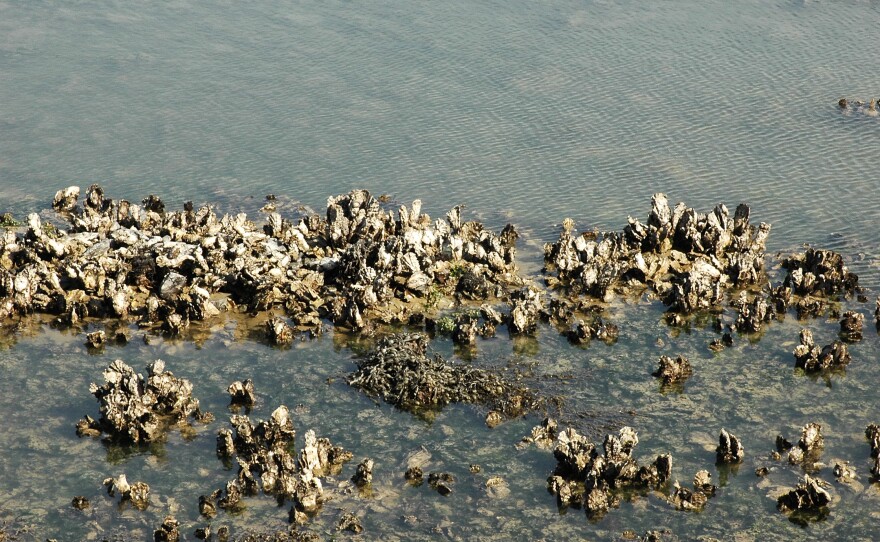Pacific oysters have a long history of gracing restaurant menus in Southern California. The water-filtering shellfish has also been grown in local waters for nearly a quarter of a century. The Japanese mollusks are Dennis Peterson's bread and butter.
"It's a very robust oyster. It grows fast. It grows well. And it tastes really good," Peterson said.
Peterson helps run Southern California's only aqua farm. The operation has grown shellfish in a Carlsbad Lagoon since 1990. The farm sits in the shadow of the Encina Power plant.
Surveying the calm water in the lagoon, Peterson pointed out the rafts that mark the location of the underwater farm.
"Under these rafts are oyster, mussel, clam," he said. "The clam and oysters are in trays like we've seen. The mussels are in the big tubes hanging beneath the rafts."
Like any crop, oysters start off with seed stock. The small larvae grow quickly in an upwelling tank. The tank constantly moves water over the shells.
"Once they're of size, they're transferred to these trays and put out into the lagoon in stacks in these trays," Peterson said. "At that point they're brought in every three weeks and tumbled to keep them separate and help them grow in a cup shape."
Keeping the oysters separated is important because the bivalves will glue themselves to hard surfaces.

"They tend to form clusters on rocks, set on top of each other," Peterson said as he pointed to a bucket full of maturing oysters. "And they will form, over a period of time, oyster reefs."
It is that reef-building ability that has the attention of biologist Jeff Crooks. Crooks has had an interest in non-native species since he studied at the Scripps Institution of Oceanography. He speculated that the non-native Pacific oyster likely spread in water carried in ship ballast tanks.
And he said they have gained a foothold along the Southern California coast.
"This is one of the biggest, most conspicuous things around now, but it didn't used to be here when I first started out," Crooks said. "It is only in the last 10 years or so that these things have started to appear."
The oysters are easy to find, especially at low tide. Crooks stood on the rip rap in Tuna Harbor adjacent to downtown San Diego and pointed to the water's edge.

"So what we're looking at are a cluster of shellfish right here, growing on this rock," he said. "The biggest one is probably eight to nine inches. They can even get much bigger than this."
The shellfish's ability to grow makes them valuable commercially, and it helps when competing for space in a new habitat. The mollusks are also ecosystem engineers and they can fundamentally modify the area in which they live.
"Oysters unlike most other things, are able to change systems so they can form big reefs — they get very dense," Crooks said. "They can help clear the water, they provide structure, they provide habitat for other animals, perhaps. But at the same time they can take up space. Native species might be impacted."

That might not be a huge deal at Tuna Harbor where there is very little natural habitat, but consider the South Bay: Pacific oysters could take over tidal mud flats that currently support a wide variety of life.
"When they start growing in softer sandier areas, and attach to smaller rocks or other kinds of, then you really get the transformation," Crooks said. "You get a transformation from a mud flat, from a tide flat, to an oyster bed. And those are very different sorts of habitat that support different species."
Researcher Danielle Zacherl said that's a valid concern. The UC Fullerton biologist has successfully reintroduced the native oysters at a couple of Southern California locations because olympia oysters were nearly fished and polluted out of existence.

She's considered a San Diego restoration effort, but she concedes the Pacific oysters might out-compete the smaller slower growing natives. Even so, she is enthusiastic about helping a key habitat type return to the region.
"Imagine a whole habitat type completely disappeared, like all the kelp forests, and what an enormous impact that would have on community diversity or on habitat structure," Zacherl said. "So one has to wonder how different Southern California estuaries are now than they might have been 100 years ago when oyster beds were present."
The quandary for biologists is predicting the impact pacific oysters will have. If that impact turns out to be bad there might not be much that can be done to correct it. That's because removing a fast-growing invasive species that's already established itself may not be possible.






